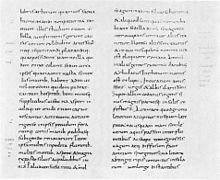Pomponius Mela

Pomponius Mela was an ancient Roman geographer and cosmographer from Tingentera on the north bank of the Strait of Gibraltar . In the years 43–44 AD, in the early Roman Empire , he wrote a description of the geographical world known at the time. Their title is De chorographia libri tres , Cosmographia or De situ orbis .
plant
Mela's work is considered to be the oldest geographical work written in Latin. It is known from over a hundred manuscripts and later editions, together with extensions. Francesco Petrarca and Giovanni Boccaccio, among others, had copies made. It has always been highly valued by scholars and inquisitive people, because many places such as the Taunus , Trier , the Main , parts of Lake Constance and Scandinavia, mountains and rivers are mentioned for the first time in Mela's work . Mela describes a trip by ship, on which he explains topographical details, describes sights and islands. He reports realistic details from fauna and flora, in which fantastic mythical creatures appear, he introduces the inhabitants of individual areas and tells their story, their customs and the various religions, especially around the Mediterranean.
Melas' representations refer primarily to older, mainly Greek sources such as Homer , Hanno and Cornelius Nepos .
In the Age of Discovery, Mela's work was rated as very important, so that, among others, the personal physician and astronomer of King Manuel of Portugal , Joan Faras, had a Spanish translation made for the expedition to Brazil. The discoverer of Brazil, Pedro Álvares Cabral , also owned a Latin edition of Melas De chorographia with many handwritten notes , which had appeared in Salamanca in 1498.
The font by Pomponius Mela was later also called De situ orbis .
Editions and translations
- Cosmographia Pomponij Mele Authoris nitidissimi Tribus Libris digesta. Nuremberg 1512.
- De orbis situ: libri tres. Cum commentariis Ioachimi Vadiani . Christian Wechel, Paris 1530 ( digitized edition of the University and State Library Düsseldorf ).
- De chorographia libri tres . Edited by Carl Frick. Teubner, Leipzig 1880; Reprint: Teubner, Stuttgart 1968.
- Cruise the Old World. Bilingual edition. Edited by Kai Brodersen . Scientific Book Society, Darmstadt 1994, ISBN 3-534-12349-2 .
literature
- Gunnar Ranstrand: Text-critical contributions to Pomponius Mela . Almquist & Wiksell, Stockholm 1971.
- Frank E. Romer: Pomponius Mela's description of the world . Univ. of Michigan Press, Ann Arbor 1998.
- Renate Frohne: The world and image of man by the St.Gallen humanist Joachim von Watt / Vadianus (1484–1551) - illustrated using selected excursions in the scholias of Pomponius Mela: De chorographica , Basel 1522 (2nd edition, Gardez-Verlag 2010).
Web links
- Literature by and about Pomponius Mela in the catalog of the German National Library
- Cosmographia, sive De situ orbis. Prisciani ex Dionysio de orbis situ interpretatio , Erhardus Ratdolt, Venice 1482 - digitization requires special program
- Cosmographia ive De situ orbis as hypertext, French translation and original Latin text - with good structure
- De Chorographia , Latin text (Latin Library) - text of the Cosmographia, only with a different title
Remarks
- ↑ The place name is only passed down from his work. It is therefore not certain whether Tingentera is identical to Julia traducta , today's Algeciras , or whether it was a neighboring town, for example on the site of today's Tarifa .
| personal data | |
|---|---|
| SURNAME | Pomponius Mela |
| ALTERNATIVE NAMES | Mela, Pomponius |
| BRIEF DESCRIPTION | Roman geographer and cosmographer |
| DATE OF BIRTH | 1st century BC BC or 1st century |
| PLACE OF BIRTH | Tingentera (Algeciras) |
| DATE OF DEATH | 1st century |
